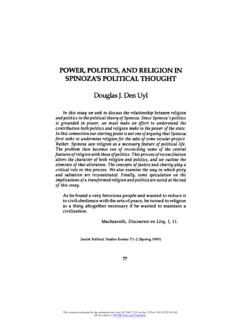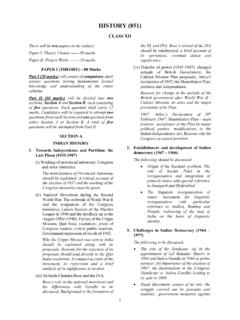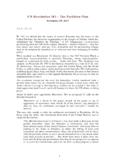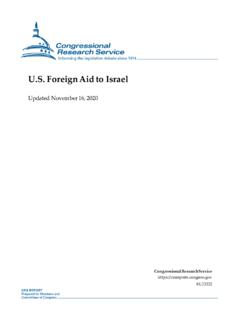Transcription of Timeline of main evenTs in The hisTory of israel
1 Timeline of main evenTs in The hisTory of israelBiblical Period 1600 BCE Abraham, Isaac, and Jacob forefathers of the Jewish people and bearers of the faith in one God settle in the Land of israel The tribes of israel go down to Egypt because of a severe famine in the Land of israel 1200 BCE The Exodus from Egypt, the gathering at Mount Sinai 1200-1100 BCE The tribes of israel settle in the Land of israel 1020 BCE The Kingdom of israel is established; Saul the first king 1000 BCE Jerusalem becomes the capital of the Kingdom of israel under King David 960 BCE The First Temple, the national and spiritual center of the people of israel , is built in Jerusalem by King Solomon 722-720 BCE The Kingdom of israel that is located in the northern Land of israel is conquered by Assyria; ten tribes go into exile 586 BCE The Kingdom of Judah is conquered by Babylonia; Jerusalem and the Temple are laid waste.
2 The Jews are exiled to Babylonia The Second Temple Period 538-515 BCE The Return to Zion after the proclamation of Cyrus masses of Jews return from Babylonia; the Temple is rebuilt 332 BCE The Land of israel is conquered by Alexander the Great; Hellenistic rule 166-160 BCE The Hasmonean Revolt against the Greek Empire in reaction to the constraints imposed on Jewish religious practice 129-63 BCE Jewish political independence under the Hasmonean Kingdom 2 The Period of Roman Rule 63 BCE to 4 CE King Herod, a Roman vassal, rules in the Land of israel .
3 The Temple is expanded and becomes a spectacular compound 66 The Jews rebel against the Romans 70 The destruction of Jerusalem and the Second Temple 73 The Romans battle to conquer Masada 132-135 The Bar Kochba Revolt against the Romans 136 The Romans change the name of Judea to Syria Palaestina and the name of Jerusalem to Aelia Capitolina. Jews are forbidden to settle in the Land of israel Changing Foreign Regimes 614 The Persian invasion 638 The arab conquest 638 The liberation of Jerusalem by a combined force of Persians and Jews 638 Conquest of Jerusalem by the Second Caliph.
4 Umar ibn al-Khattab Renewal of the Jewish community in Jerusalem 691 The Dome of the Rock is built on the Temple Mount by the caliph Abd al-Malik on the presumed location of the First and Second Temples 1099-1291 Crusader rule 1291-1516 Mamluk rule 1517 Ottoman rule The Modern Period 1863 The relative Jewish majority in Jerusalem is renewed 1882-1903 The First Aliyah 3 1897 The First Zionist Congress in Basel under the aegis of Binyamin Ze ev Herzl 1901 The establishment of the Jewish National Fund an organization for purchasing land for Jewish settlement in the Land of israel 1904-1914 The Second Aliyah mostly Jews from Eastern Europe and Yemen 1909 The founding of the first kibbutz Kibbutz Degania on the shore of Lake Kinneret (the Sea of Galilee)
5 May 16, 1916 The Sykes-Picot Agreement between France and Britain, which delineated the two powers Middle Eastern areas of rule in the Ottoman Empire once the First World War had ended November 2, 1917 The Balfour Declaration a document signed by British foreign minister Lord Arthur James Balfour, which espouses a national home for the Jewish people in the Land of israel January 3, 1919 The Faisal-Weizmann agreement between Chaim Weizmann and Emir Faisal an agreement that envisaged the relations between the Arabs in the arab state to be established and the Jews in the Land of israel April 25, 1920 The San Remo Agreement that gave Britain rule over the Land of israel after the fall of the Ottoman Empire, and ratified the creation of the national home for the Jewish people in the Land of israel under the aegis of the British power May 1-7, 1921 arab riots in Jaffa, Petah Tikva.
6 Rehovot, Hadera, and elsewhere, in which 43 people were killed. The riots were spurred by the arab national awakening and the demand to annul the Balfour Declaration July 24, 1922 The removal of Transjordan from the Jewish national home and its transformation into the Emirate of Transjordan (in the future, the Kingdom of Jordan) in the framework of the publication of the first British White Paper The Establishment of the British Mandate over the Land of israel August 23, 1929 Riots in Hebron, Jerusalem, and Safed.
7 Arabs murder 133 Jews. July 7, 1937 The Peel Commission the partition resolution is accepted by the British administration, Ben-Gurion, and the Zionist institutions, and is rejected by the Arabs 4 1934- 1948 Aliyah Bet illegal immigration to israel the bringing of Holocaust survivors to the Land of israel April 1936 to 1939 The disorders of the arab Revolt and suppression by the British 1939 Publication of the third White Paper by Malcolm MacDonald, which restricts Jewish immigration to the Land of israel March 22.
8 1945 The establishment of the arab League with Cairo as its hub November 29, 1947 Approval of the partition plan by the General Assembly of the United Nations Resolution 181 Establishment of the State of israel November 29, 1947 to July 20, 1949 The War of Independence; from May 15 to June 11 the regular arab armies invasion of the Land of israel . 6000 Jews were killed during the war. May 14, 1948 Declaration of statehood by David Ben-Gurion, chairman of the Jewish Agency, before the Provisional State Council February 24, 1949 to July 20, 1949 Armistice agreements (Rhodes agreements): February 24 Egypt, March 23 Lebanon, April 3 Jordan, July 20 Syria 1948 (until 1967) Jerusalem is divided between israel and Jordan along the armistice lines: Jordan holds the eastern part of the city, israel the western and southern parts.
9 Jews are denied access to the Old City and the holy places in contravention of the armistice agreement 1949 Massive aliyah to israel from arab states and North Africa, and of displaced Jews from Europe. The Jewish population doubles from 650,000 to 1,300,000 May 11, 1949 israel is accepted as the 59th member of the United Nations December 5, 1949 Jerusalem is declared the capital of israel by David Ben-Gurion 1951 A UN Security Council resolution condemns Egypt s blocking of the Suez Canal 5 1956 Egypt s blocking of the Straits of Tiran and emplacement of coastal artillery at Ras Natzrani - one of the main causus belli for the launching of the Sinai Campaign by France, Britain, and israel October 29.
10 1956 to November 5, 1956 The Sinai Campaign conquest of the Sinai Peninsula November 1, 1956 Establishment of the United Nations Emergency Force, UNEF June 2, 1964 The founding of the PLO the Palestine Liberation Organization whose purposes are: to represent the Palestinian people and to wage armed struggle aimed at destroying the State of israel June 5, 1967 to June 10, 1967 The Six-Day War between israel and arab states: Egypt, Jordan, Syria, Lebanon, and Iraq August 29, 1967 to September 1, 1967 Meeting of the arab League in Khartoum, which laid down the three no s.









